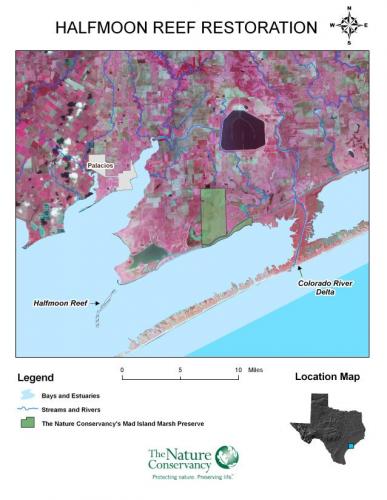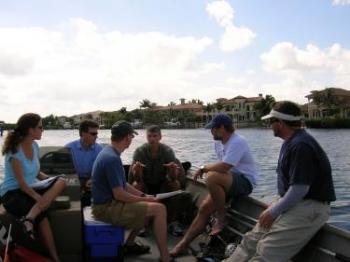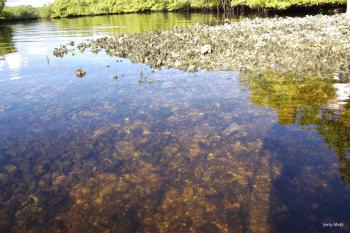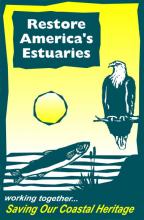|
Shellfish Restoration
Network
|
Distributed by The Nature Conservancy's Global Marine Initiative
|
Half Moon Oyster Reef Restoration Gets a Green Light By Mark Dumesnil, Texas Coastal Program The Nature Conservancy’s Coastal Program in Texas got some really great news recently. They were chosen by the multi-agency Estuary Habitat Restoration Council to receive project funding to undertake the construction of an approximate 15 acre oyster reef in Matagorda Bay, Texas. The project site is generally known as Half Moon Reef and represents an area of consolidated substrate that appears to be very conducive to successful reef construction. Information gathered from state fisheries biologists suggests that this reef was once a very large and productive oyster reef. Today very little cultch material exists and recent samples indicate the presence of some shell but not in the quantities necessary to naturally re-establish the reef. The current substrate is mostly compacted clay, sand and some small amounts of shell material. In 1934, when the nearby Colorado River was diverted away from Matagorda Bay so that it discharged more directly into the Gulf of Mexico, the salinity of Matagorda Bay was changed dramatically, causing Half Moon Reef to degrade. In 1991-1992, however, the Colorado River was reconnected with West Matagorda Bay, restoring some of the historical hydrology to the reef. Recent studies suggest that a portion of the freshwater inflows from the Colorado River do in fact flow over Half Moon Reef, providing a salinity regime much better suited for oyster propagation and sustainable growth. Based on initial assessments of the site, the reef appears to be cultch (shell substrate) limited and not limited by spat (juvenile oyster) settlement. The project proposes to collect and deposit oyster shell and/or limestone marl as cultch material to create additional surface area for natural spat settlement and oyster accumulation. The project will be surveyed prior to construction and then monitored post-construction to determine the success of the project. The TNC Coastal Program in Texas, along with TNC’s Gulf of Mexico Initiative Director Rafael Calderon, will work closely with local conservation partners and members of TNC’s Global Marine Team to determine the best approaches for monitoring the project to document the reef’s recovery, with the evaluation of ecosystem services such as fish habitat and water filtration in mind. At this time, the Conservancy is soliciting additional non-federal funding to complete the project as required by the Estuary Habitat Restoration Program. “We are very excited about this opportunity to work with the Corps and our many marine partners on the Texas coast to finally have an opportunity to take a well planned shellfish restoration project to scale. TNC has done many smaller shellfish restoration projects around the U.S., and this project is among the largest projects we’ve attempted” said Rafael Calderon. Read more about oyster restoration projects in Texas. Read more about TNC's Gulf of Mexico Initiative.
|
|
Innovative Partnership for Oyster Restoration in the Loxahatchee
The Loxahatchee River is the southern-most tributary of Florida’s Indian River Lagoon, and is connected to the Atlantic Ocean through Jupiter Inlet. In 1985, the Northwest Fork of the Loxahatchee River was federally designated as Florida's first Wild and Scenic River. In addition, different portions of the River and estuary are also designated as an aquatic preserve, Outstanding Florida Waters and a state park. Like many estuaries along the Atlantic coast, however, development and other pressures have affected the viability and abundance of oyster reefs that are important for the overall health of the lagoon. Restoration of oyster reefs in the Loxahatchee River is rooted in strong and diverse partnerships including local and federal agencies, universities, and conservation groups. Dr. Albrey Arrington with the Loxahatchee River District is the lead on the project, with primary responsibilities for obtaining permits and overseeing the on-the-ground restoration activities. Andrea Povinelli of The Nature Conservancy’s Indian River Lagoon Program & Blowing Rocks Preserve office serves as the lead for engaging and involving local community members and homeowners who will ‘host’ oyster reefs constructed beneath their docks along stretches of the river. Dr. Craig Layman from Florida International University along with scientists at NOAA’s Southeast Fishery Science Center is leading the scientific assessment of restoration success. Other partners are contributing much to the project as well. South Florida Water Management District and the Loxahatchee River Preservation Initiative are providing matching funds. Palm Beach County Environmental Resources Management is providing limestone rock to be used as substrate for oysters along part of the river’s shoreline, and Martin County’s Artificial Reef Program is donating concrete reef balls, made mostly be local students, for placement under homeowner’s docks. Friends of the Loxahatchee River is helping to collect and bag recycled oyster shells from local restaurants that will ultimately be used for comparison with the reef balls and limestone rock reefs. Two methodologies will be used to monitor the success of the restoration projects from a scientific standpoint. First, Dr. Craig Layman and his team from FIU will monitor the benthic fauna (e.g., small fishes, crabs, shrimp) that utilize oyster habitat bi-monthly for one year following the restoration of reefs. They will compare the abundance, diversity and size of organisms that colonize the restored reef sites to control sites currently being monitored in existing reef habitat. Second, Dr. Layman’s team is using an innovative methodology, acoustic telemetry, to track the movements of individual fish to measure the fidelity of fishes at the restoration sites. Using this approach, they will determine whether fishes have a higher site fidelity (i.e., spend longer periods of time) at the dock sites after oyster shell is added. Students and community members are directly involved in this work as well, by sponsoring tags used in the study through the Adopt a Fish program. In addition to providing invaluable insights about the ecology of fishes in the river, students and others can go online to track the specific fish that carries their tag, and follow its migrations throughout the river! Restore America’s Estuaries’ 4th National Conference – “Creating Solutions Through Collaborative Partnerships”
Habitat restoration offers great promise for reversing trends of habitat loss and degradation and is a crucial component of comprehensive ecosystem restoration, protection and management. The Conference Program will address all aspects of coastal and estuarine habitat restoration that involves the manipulation of the physical, chemical or biological characteristics of a site with the goal of returning self-sustaining natural or historic structure and functions to former or degraded habitat. Beyond the plenary presentations and thematic sessions in the program, conference participants will also have the opportunity to partake in field sessions, special evening events, explore and network with the more than 140 exhibitors in the Restoration Expo, and review more than 120 poster presentations in the Poster Hall. If you have questions about registering, exhibiting, and/or sponsoring the 4th National Conference, please visit the RAE web site or contact Harvey Potts by email or (206) 624-9100. Looking Ahead 4th
National Conference on Coastal and Estuarine Habitat
Restoration 11th
International Conference on Shellfish Restoration
(ICSR) International
Marine Conservation Congress – Making Marine Science
Matter Web Resources The Practitioner’s Guide to Shellfish Restoration: An Ecosystem Services Approach, as well as back issues of the Shellfish Restoration Clamor are available online. Cool Video! Common Ground by Chesapeake Bay Foundation Another Cool Video! Blue Oyster Blues by Imaginary Friend, 2007 Guidance on methods for monitoring oyster reef restoration projects is available at the Oyster Restoration Workgroup website. | |||
|
|
 | ||







